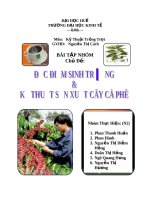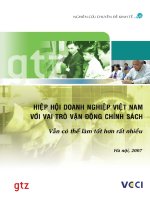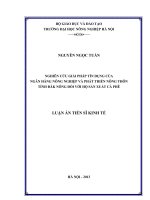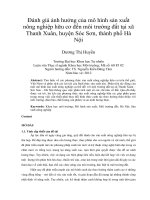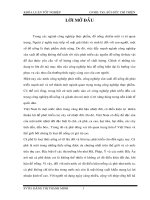Sản xuất cà phê hữu cơ (English)
Bạn đang xem bản rút gọn của tài liệu. Xem và tải ngay bản đầy đủ của tài liệu tại đây (964.41 KB, 15 trang )
THE UNIVERSITY OF NEW ENGLAND
SCHOOL OF ENVIRONMENTAL AND RURAL SCIENCE
UNIT
ORGANIC AGRICULTURE: Principles and Practices
TOPIC
GLOBAL ORGANIC COFFEE PRODUCTION
Student name: Van Long Nguyen
Student number: 220119137
Teacher: Paul Kristiansen
Words count: 3,049 words
Contents
1. Introduction 1
2. The benefit of organic coffee production 1
2.1.Environmental benefits 1
2.2. Health benefits 2
2.3. Farmer benefits 2
3. Global organic coffee production 3
3.1.The production and current size organic coffee 3
3.2. Global market of organic coffee 4
4. Certifications and standard regulations of organic coffee 5
5. Price of organic coffee. 7
6. Organic coffee practices 8
6.1.Using biological control of coffee berry borer 8
6.2. Shade coffee 9
7. Conclusion 10
References
Tables and figures
Figure 1: The development of global organic coffee areas 3
Figure 2: Land coffee under organic management worldwide 4
Figure 3: exports of organic coffee by exports countries from 2005 to 2012 5
Table 1: FLO Fairtrade minimu price and Fairtrade premium for coffee per pound 7
Acronyms
EU
Europe
FLO
Fairtrade Labelling Organizations International
Ha
Hectares
ITC
International Trade Center
ICO
International Center Organization
IFOAM
International Federation of Organic Agriculture Movements
JAS
The Japan Agricultural Standard
1
1. Introduction
Coffee plantation is the permanent crop that has been contributing to the eco-social
development of many countries, especially developing nations. It is also the most traded tropical
agricultural worldwide commodity. Currently, there are two main coffee species in global coffee
market: Arabica is the better beans, account for about 70 percent of global coffee, 30% is of
Robusta coffee. Between 2009 and 2010, global coffee exports of both Arabica and Robusta was
93.4 million bags (60kg/bag), bringing in an estimated US$15.4 billion. Brazil and Vietnam are the
two largest exporters with 2.7 and 2.0 million bags (ICO, 2014); however, Europe has the biggest
coffee consumption in the world. In 2008, coffee accounted for 31% of worldwide consumption
followed by United States (17%) and Japan (6%).
These figures consist of both organic and non-organic coffee. Meanwhile, organic coffee
accounts for 6.6% of total coffee export, is approximately 6.1 million bags and it is projected to
significant increase in the future (ICO, 2014). International Trade Center (ITC) (2011) stated that
‘organic coffee is grown as part of an intensive, holistic agricultural production management
system that includes the composting of organic materials, mulching, shade regulation and
biological pest control’. This research will discus benefits of organic coffee, provide general
information about the development of global organic coffee, and certification of organic coffee as
well as organic coffee practices in order to understand organic coffee production.
2. The benefits of organic coffee
2.1. Environmental benefits
Friendly environment is one of the principles in organic coffee production. There are free
of synthetic fertilizers and pesticides, so the soil is probably clear of toxic chemicals that cause
soil pollution. Moreover, organic coffee production will contribute to protect and develop
forestry. Deforestation cannot occur in organic coffee production, because most coffee is planted
under shade of forest (EthicalCoffee.net, n.d.). Additionally, diversity of vegetation and birds will
provide nutrients, keep water, control pest and insects; especially make good conditions for coffee
development. A good ecosystem can supply adequate nutrient for plants, resulting in reduction of
demand for chemicals (Campbell, 2013). Furthermore, shade trees provide homes for native birds
2
and local wildlife. Birds help farmers control insects and pests (EthicalCoffee.net, n.d.). On the
other hand, deforestation may occur in conventional practices that will damage ecosystem and
biodiversity. This results in disappearing nutrients, reducing predators of coffee pests. Perfecto
(2005, p.436) has emphasized that ‘in these traditional plantations, coffee is grown under a
structurally and floristically diverse canopy of shade trees, which provide habitat for a high
diversity of associated flora and fauna’. Therefore, shaded coffee has strong relationship with
biodiversity including birds and arthropods as well as creating habitat for biodiversity. In
addition, growers plant permanent sod cover between rows in order to encourage biological
habitat, enrich soil organic matter and most importantly prevent erosion (Dill, 2009).
Furthermore, consumers are aware of environmental issues, so they are concerned about the
negative effects of chemicals on the environment. As a result, products that causes harmful for
environment will be ignored.
2.2. Health Benefits
The difference between conventional and organic production is input materials. While
conventional practices use synthetic materials such as fertilizers, pesticides to produce products,
organic practices produce natural products without chemicals. Therefore, organic foods are free of
chemical residue (ITC, 2011). The quality of coffee depends mostly on process which is worked at
coffee farms, so farmers also contact with all inputs. For this reason, buyers not only worry that the
beverages that they drink will damage health, but also are concerned about farmers who have to
work with chemicals. According to Campbell (2013), the percentage of insecticides, herbicides and
fungicides with 30%, 60% and 90% respectively are carcinogenic, causing cancer. The nervous and
reproductive systems are damaged by pesticides and conventional farming chemicals. However,
currently there is no evidence to prove chemical residue on coffee product, but drinking organic
coffee can minimize the health risks compared to drinking non-organic coffee.
2.3. Farmer Benefits
Small organic growers have to compete with the large conventional producers both in
price and productivity. Organic coffee is produced under organic practices, so that the yield is not
as high as modern methods. Consequently, organic farmers always get less than their production
costs. This can result in bankrupt organic products (Campbell, 2013; ITC, 2011). Campbell,
3
(2013) pointed out that Fair trade cooperatives must pay higher and guaranteed price to farmers to
maintain organic coffee products as well as the livelihood of organic growers. As a result, in
2008, the coffee market paid about an extra 15 cents per pound premium for the organic coffee
bean and growers are paid $1.41 fee per pound if they had a certified organic coffee. Overall,
farmers benefit from their income and health in organic coffee production.
3. Global organic coffee
3.1. The production and current size organic coffee
As many organic products, organic coffee growth is sustainable. The Figure 1 shows that
there is a significant increase in global organic coffee land from 176,139 hectares (Ha) in 2004 to
695,959 Ha in 2012. Organic coffee land occupied nearly 2% of total 37.5 million ha organic
farming worldwide and 6.6% of the world’s harvested coffee area (Willer, Helga and Lernoud,
2014). Three countries that have high organic area sharing were Sao Tome and Principle (98.8%),
Bolivia (46.5%) and Nepal (45.9%). Brazil is the largest producers with 2.1 million ha, following
by Indonesia with 1.2 million Ha, Colombia and Mexico 0.7 million Ha for each and Vietnam has
only 0.5 million Ha (IOC, 2014). However, Mexico is the largest organic coffee land in the world
with about 243,000 ha, Ethiopia 147,000 Ha.
Figure 1: The development of global organic coffee areas
Note: Reproduced from The world organic agriculture by Willer, Helga & Lernoud, (2014)
176,139
311,469
399,464
546,541
463,859
545,902
626,547
627,333
695,959
-
100,000
200,000
300,000
400,000
500,000
600,000
700,000
800,000
2004 2005 2006 2007 2008 2009 2010 2011 2012
Hectares
Year
4
According to ICO (2014), the global outbreak of coffee planting and drinking began in the
Horn of Africa. The most coffee is grown in Latin America and Africa. They also have the largest
area of organic coffee with 62% of total worldwide organic coffee (Figure 2), the second place is
Africa with 28%.
Figure 2: Land coffee under organic management worldwide
Note: Reproduced from The world organic agriculture by Willer, Helga and Lernoud, (2014)
Although organic coffee area continues to significantly increase, the ratio of organic to no-
organic coffee is low (6.6%). This is caused by four key reasons including: (1) the organic coffee
yield is lower than others; (2) the price of organic products is quite higher; (3) growers are very hard
to achieve organic certification and (4) the competition between organic and nonorganic is intense.
3.2. Global market of organic coffee
The global consumption of organic coffee was sustained increase rates in many high
income countries. Natural food stores in Europe sold most organic coffee, while mainstream
supermarkets are places selling organic coffee in Germany, Switzerland (Ponte, 2004). In 2006,
global imports of organic coffee that achieved 67,000 tonnes, was 15,00 and 25,000 tonnes higher
than in 2005 and 2003 (Liu, 2008). Lui (2008) stated that 30,700 of tonnes organic coffee in 2006
were imported by North America, occupied 46% of worldwide imports. Meanwhile, over 85%
28%
8%
62%
2%
Africa
Asia
Latin America
Oceania
5
organic coffee, in North America, were consumed in the United States. Currently, there are two
kinds of organic coffee. The most organic Arabica market is in United States, whereas Robusta
coffee is sold mostly in European markets.
Likewise, the number of organic coffee exports has grown considerably. According to
ICO (2013), amount of organic coffee export in 2012 tripled 2005 (Figure 3) and is predicted that
continue to increase in the future. Three nations with highest exports are Honduras with 18,196
tonnes, accounting for 29.5% of total global organic coffee; Ethiopia and Indonesia with 9,495
tonnes (15.4%) and 8,465 tonnes (13.7%) respectively (ICO, 2013).
Figure 3: Exports of organic coffee by exports countries from 2005 to 2012 (in tonnes)
Note: Reproduced from Exports of organic coffee and differentiated coffees Calendar
years 2005 to 2012 by ICO (2013)
4. Certifications and standard regulations of organic coffee
The certification of organic coffee appeared in the 1980s. Organic coffee production, a part
of organic agriculture, is a production management system encouraging and increasing both
biodiversity and soil activity. It aims to minimize use of chemical inputs, promote natural
management in order to remain, protect and enhance ecological system (Ponte, 2004). Ponte (2004)
stated that organic producers may be certified by private or public certification company, if they
follow standards and procedures including (1) no synthetic agro-chemicals on coffee farm at least
three years prior to certificate; (2) details, methods and materials that applied in coffee production,
21,862
24,536
29,300
36,890
37,706
42,646
52,303
61,741
-
10,000
20,000
30,000
40,000
50,000
60,000
70,000
2005 2006 2007 2008 2009 2010 2011 2012
Tonnes
Year
6
have to be recorded by producers or farmers; (3) third party certifier inspects annually all methods
and materials.
Figure 4: Official Organic seals in European Union, United States, Japan (ITC, 2011)
Figure 5: Several worldwide organic coffee certifications (Coffeeathomeguide.com, 2013)
Nevertheless, organic coffee certification has some trouble. Although, standards for
organic agriculture were set up by the International Federation of Organic Agriculture
Movements (IFOAM), currently, different rules have been applied in different countries. Organic
coffee importation and sale need to follow the legal regulations of the importing countries. ICO
(2013) showed that there are more than 21 organic coffee certifiers around the world and each
individual market requires different standards and regulations. For instance, the regulation of the
market for certified organic food in the European Union is regulated by Council Regulation No
834/2007 and subsequent amendments. However, all imported products in Japan must follow The
Japan Agricultural Standard (JAS). According to Ponte (2004,p.17), approval of imports has three
different systems: ‘approval of country, importer derogation, and approval of a certification
7
organization’. Sometimes the systems are not harmonized. Therefore, an organic product may be
accepted by a market but rejected by another markets.
The cost for achieving organic coffee certification is quite high. In terms of organic coffee
exports, inspection and certification have to apply all steps including processing, the storage and
handling and delivering. ITC (2011) emphasized that the cost of inspection and certification are
not to exceed 3-4% of sales value, but some growers and organizations have to pay more than
this. Importantly, local certifiers also are not cheaper than international organizations.
Consequently, organic coffee producers not only bear the inspection and certification costs, but
also have to face with low yield. Furthermore, growers find it very hard to get organic coffee
certification, because they have to prove both products and soil are free fertilizers and chemical
residue (Ponte, 2004). This process takes a long time as at least three year period.
5. Price of organic coffee
The price of organic coffee is always higher than conventional coffee. Organic coffee
certification is an expensive process and a huge money costs for annual inspections, but growers
and organizations will get large benefit when they achieve organic coffee certification through
price premium. To illustrate this, in 2008 the FLO (Fairtrade Labelling Organizations
International) systems has a guarantee the prices of organic coffee product. Table 1 shows that
depending on kind of coffee, Fairtrade minimum is ranging from 1.01 to US$1.70 per pound.
Additionally, in order to improve social, economic, environmental conditions, what workers and
farmers received from Fairtrade premium is US$0.20 per pound.
Table 1: FLO Fairtrade minimu price and Fairtrade premium for coffee per pound (US$)
Variety
Quality
Characteristics
Fairtrade Minimum
price
Fairtrade
premium
Arabica
Conventional
Washed
1.40
0.20
Non-washed
1.35
0.20
Organic
Washed
1.70
0.20
Non-washed
1.70
0.20
Robusta
Conventional
Washed
1.05
0.20
Non-washed
1.01
0.20
Organic
Washed
1.35
0.20
Non-washed
1.35
0.20
Note: Reproduced from Fairtrade minimum price and fairtrade premium by FLO (2012)
8
6. Some organic coffee practices.
Currently, there are many organic practices in coffee production. Research discusses two
main methods that apply in organic coffee production.
6.1. Use of biological control of coffee berry borer Hypothenemus hampei (H. hampei)
While conventional farmers prefer to use pesticides, organic farming growers use methods
such as cultural control, hand collection of ripe and over ripe berries, biological control and traps.
The purpose of pest control in organic farms is not to eradicate pests, but to keep the levels of pests
under control. Biological control of coffee berry borer, a part of natural control in organic coffee
production, is used to replace chemical control. The coffee berry borer is the most important
worldwide pest. It is very difficult to control by chemical pesticides because the life cycle mostly
occurs inside the berry (Damon, 2000). Damon (2000) indicated that use of chemical pesticides to
control coffee berry borer such as endosulfan that takes up to 79% efficient control but the liquid
causes food poisoning and residual effects last for 7.5 months. Furthermore, chemical not only kills
all organisms, but also encourage the resistant chemical of pests. Biological control of coffee berry
borer is mainly conducted by using wasps Cephalonomia stephanoderis, entomopathogens,
parasitoids, ants and nematodes. These natural enemies parasitize in the adult female borers and kill
them. Wasps attack the borer before damaging the development of coffee bean when they move
from berry to berry (Montoya, 2005). According to CABI Bioscience (2003), in Colombia, natural
levels of Beauveria bassiana can kill up to 80% mortality of adults when they are attacking young
berries under humid climate. The advantage of fungi that there are no detrimental effects to humans
or other wild life. Similarly, Montoya (2005) has proven that eulophid parasitoid Phymastichus
coffea has a potential to control H. hampei. The age of the berries and the position of the beetle
inside the berries considerably affected the success of using Phymastichus coffea. Vandermeer
(2010) noted that although ants, Azteca ants, occupies from 3 to 5% of the farm, they contribute
greatly to pest control such as beetles, H. hampei.
Figure 6: H. hampei, reproduced from Lante (2013)
9
6.2. Shade coffee
Shade coffee means that coffee plantations are grown by the traditional way, under forest
canopy. Shade tree is a compulsory principle in organic coffee production. Besides producing organic
coffee, many farmers are tending to grow shade trees in their farms to deal with the decrease in
worldwide coffee prices and increasing toward green consumerism (Albertin & Nair, 2004). Coffee
has been grown traditionally under shade cover; however, increasing demand for coffee consumption
leads to expectation of high yield. This resulted in converting traditional cultivation to un-shaded
systems in 1960s. Muschler (2001) has stated that this change relates to growing heavy use of
synthetic materials that caused high environmental and economic costs, soil erosion, biodiversity loss.
The role of shaded tree on coffee farms is very important. Firstly, they control microclimate
for coffee production in terms of temperature, levels of light and moisture. Souza et al. (2012)
asserted that the average temperature in un-shaded coffee farms is about 6
0
C higher than shaded
coffee farms. The regulation of light transmission of shade tree contributes to extension of coffee
life (Beer, 1987). In the dry season, about 35 to 65% of shade promote remaining coffee leaf and
decrease the incidence of disease which is caused by fungi (Staver et al. 2001). Secondly, research
has shown that via the accumulation of organic matter from leaf litter, total organic C, ntrogen and
microbial activity of soil in shade coffee is higher than unshade (Beer et al., 1998; Souza et al.,
2012). Moreover, shaded coffee promotes biodiversity as well as increase diversity of species such
as mammals, plants, arthropods and birds (Perfecto et al., 1996). Shade coffee benefits song birds
who use the coffee plant and shaded trees as a natural habitat, causes the decrease in the need for
fertilizers and herbicides. Coffee Research Institute (n.d.) stated that there are about 150 bird species
live in on the shade grown coffee farms, in contrast, 20-50 species are supported by non- shaded
coffee. Additionally, growers can get financial benefits from timber trees and fruit trees. In Ecuador,
Ramirez et al. (1992) pointed out that the exploitation of 100 Cordia alliodora trees in 12 to 16 year
rotation period is equal with one hectare of primary forest. Lastly, shade grown coffee often tastes
better. Both hight altitudes and shade, have the same effects on coffee, slow the development of
coffee. Consequently, coffee can produce more sugars and chemicals responsible for the perceived
acidity in coffee (EthicalCoffee.net, n.d.; Coffee Research Institute, n.d.).
However, shade grown coffee also has several negative influence on coffee. Average yield
of organic coffee is 22%, lower than conventional coffee organizations. Shade coffee causes over-
shading and high fungal attacks (Lyngbaek et al., 2001). Haggar et al. (2011) reported that while
the yield of full sun coffee production is 6,180 kg/ha, 4,470kg/ha is produced under shade tree
10
coffee production. Additionally, the competition between coffee and shade tree was noted by Beer
et al. (1998). Finally, there are no criteria for shade cover, so grower often shade their coffee
using other crops and heavily pruned that create less sustainably habitat for birds. This
information is not showed in the organic labels, resulting in decrease of consumer belief.
Figure 7: Growing Arabica coffee under shade trees at Kontum province, Vietnam (2013)
In order to successfully use shade trees, growers need to consider types of coffee and
shade tree. Many studies have shown that the good density of canopy for coffee growth ranges
from 20 to 60% (Muschler, 2001). Albertin & Nair (2004) asserted that in Costa Rica, several
shade trees are grown on coffee farms such as fruit (orange and avocado) and timber (Cedrela
odorata, Acacia mangium). In the same way, depending on types of forest trees, coffee producers
choose appropriate densities. For instance, the density of Cordia alliodora for one hectare coffee
was about 100 trees (Ramirez et al., 1992). In Mexico, about 61 shade species were grown, with
260 trees/Ha (Pinto et al., 2000).
7. Conclusion
Research has provided a general development of organic coffee and discussed some aspects
regarding to advantages, certificates, prices and organic coffee practices. It is clear that although
the ratio of organic to non-organic coffee is very low, organic coffee production will continue to
grow sustainably. Awareness of consumers about environmental issues and healthy foods has
been improved, thus, the products that benefit the environment and producers are consumed. This
is a golden key for organic coffee development. Furthermore, these positive effects build up the
conservation of biodiversity and create sustainable capacity for adapting coffee production to
climate change in the future.
11
References
Albertin, A. & Nair, P. K. R. (2004). Farmers’ Perspectives on the Role of Shade Trees in Coffee
Production Systems: An Assessment from the Nicoya Peninsula, Costa Rica. Human
Ecology, 32(4), 443-463.
Beer, J., Muschler, R ., Kass, D., & Somarriba, E. (1998). Shade management in coffee and cacao
plantations. Agroforestry Systems, 38,139–164.
Campbell, M. (2013). What Are the Benefits of Organic Coffee Consumption?. Retrieved from
/>CABI Bioscience (2003). Coffee Berry Borer (Hypothenemus hampei). Retrieved from
/>Coffee Research Institute (n.d.). Bird Friendly and Shade Grown Coffee. Retrieved from
/>Coffeeathomeguide.com (2013). Read the Label, picture, Retrieved from:
/>Damon, A. (2000). A review of the biology and control of the coffee berry borer, Hypothenemus
hampei. Bulletin of Entomological Research, 90, pp 453-465.
doi:10.1017/S0007485300000584.
Dill, M. (2009). From the Ground up. Organic Coffee Certification, Production and Processing.
Coffee Talk. Retrieved from www.coffeeTalk.com
EthicalCoffee.net (n.d.). Organic coffee. Retrieved from: />FLO (2009). Fairtrade minimum price and fairtrade premium table. Current version: 10.10.2012.
Haggar, J., Barrios, M., Bolaños, M., Merlo, M., Moraga, P., Munguia, R., . . . de M. F. Virginio,
E. (2011). Coffee agroecosystem performance under full sun, shade, conventional and
organic management regimes in Central America. Agroforestry Systems, 82(3), 285-301.
doi: 10.1007/s10457-011-9392-5
ICO (2013). Exports of organic coffee and differentiated coffees Calendar years 2005 to 2012.
Statistics Committee 5th meeting 6 March 2013 London, United Kingdom
ICO (2014). Statistic of exports of all forms of coffee by exporting countries to all destination.
Retrieved from />ITC (n.d.). The coffee guide:Trade practice of relevance to exporters in coffee during countries.
Retrieved from: />ITC (2011). The trend in the trade of certified coffees. Geneva: ITC,4,- 17 (Technical paper)
12
Liu, P. (2008).Value-adding standards in the North-American food market. Trade opportunities
in certified products for developing countries. FAO.Rome.
Lyngbaek, A. E., Muschler, R . G ., Sinclair, F. L ., & Beer, J. (2001). Productivity and
profitability of multistrata versus conventional coffee f arms in Costa Rica. Agroforestry
Sys-tems, 53, 205–213.
Muschler, R. G. (2001). Shade improves coffee quality in a sub-optimal coffee-zone of Costa
Rica. Agroforestry systems, 51(2), 131-139.
Montoya, E.C., Borgemeister, Jaramillo, C., Bustillo, A.E. (2005). Biological control of the
coffee berry borer Hypothenemus hampei in Colombia. Entomological Research,
95(5),467-472. DOI 10.1079/BER2005378
Perfecto, I.,Vandermeer, J., Mas, A. &
Pinto, L. S. (2005).
Biodiversity, yield, and shade coffee
certification.
Ecological Economics, 54,
435 –
446
Pinto, L.S., Perfecto, I., Hernandez, J.C. & Nieto, J.C. (2000). Shade effect on coffee production
at the northern Tzeltal zone of the state of Chiapas, Mexico. Agriculture, Ecosystems and
Environment, 80 (2000) ,61–69
Ponte, S. (2004). Standards and sustainability in the coffee sector. A Global Value Chain
Approach .International Institute for Sustainable Development. Available at http://www.
iisd. org.
Ramirez, A., Sere, C., & quillas, J. (1992). An e conomic analysis of improved agroforestry
practices in the Amazonian lowlands of Ecuador. Agroforestry Systems, 17, 65–86
Staver, C., Guharay, F., M onterroso, D ., Muschler, R . G ., & Beer, J. (2001). Designing pest
suppressive multistrata perennial crop systems: Shade-grown coffee in Central America.
Agroforestry Systems, 53, 151–170.
Souza, H. N. d., de Goede, R. G. M., Brussaard, L., Cardoso, I. M., Duarte, E. M. G., Fernandes,
R. B. A., . . . Pulleman, M. M. (2012). Protective shade, tree diversity and soil properties in
coffee agroforestry systems in the Atlantic Rainforest biome. Agriculture, Ecosystems &
Environment, 146(1), 179-196. doi: 10.1016/j.agee.2011.11.007
Vandermeer, J., Perfecto, I., & Philpott, S. (2010). Ecological Complexity and Pest Control in
Organic Coffee Production: Uncovering an Autonomous Ecosystem Service. BioScience,
60(7), 527-537. doi: 10.1525/bio.2010.60.7.8
Willer, Helga and Lernoud, J. (2014). The world of organic agriculture. Statistics and emerging
trends 2014. FiBL and IFOAM report.
